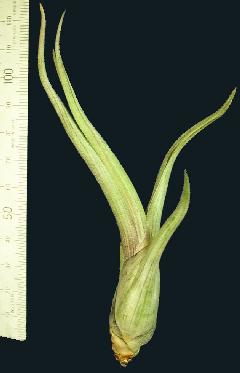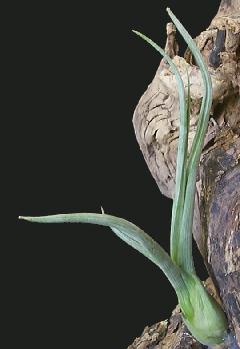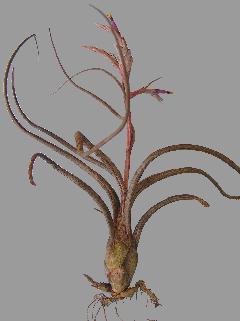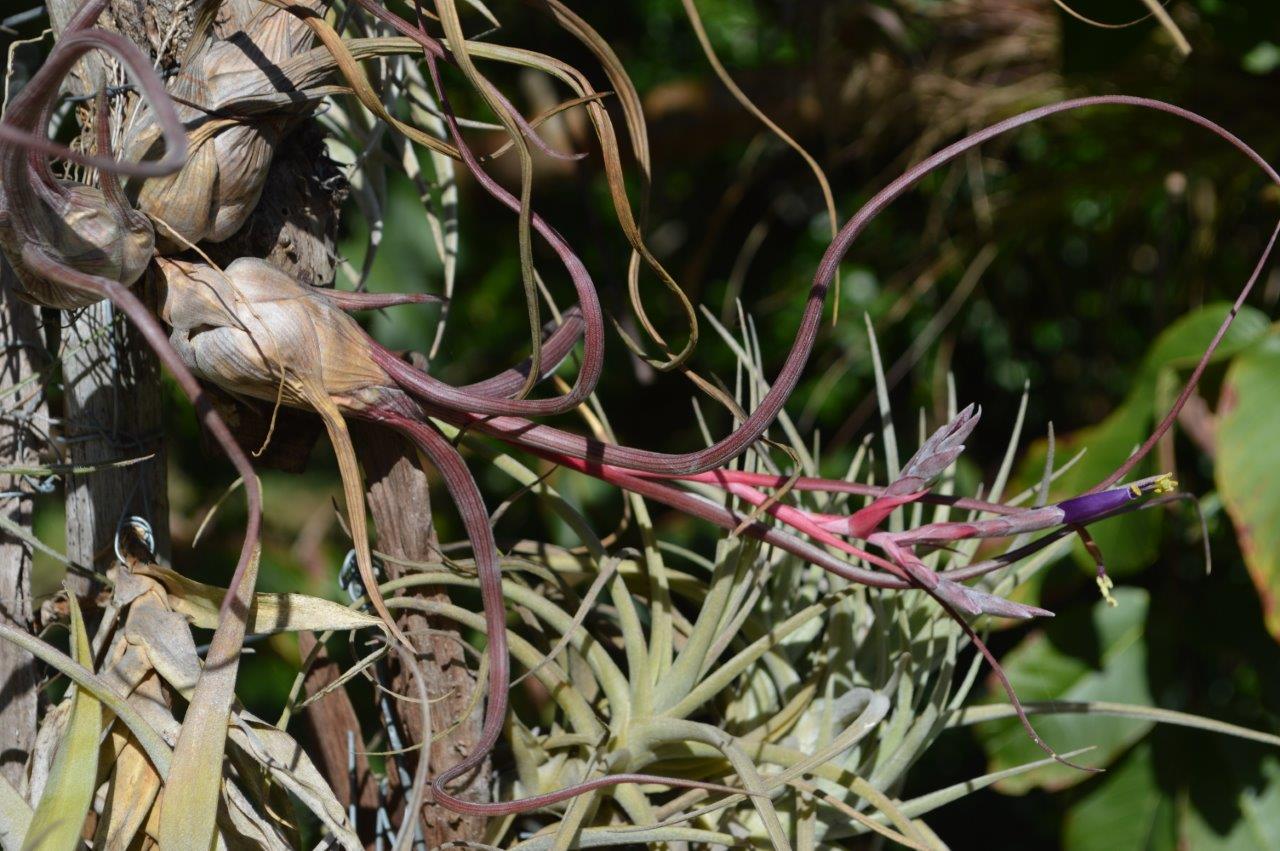



Tillandsia pseudobaileyi C. S. Gardner, Selbyana 7: 363. 1984
Tillandsia baileyi auct. non Rose: L. B. Smith & R. J. Downs, Tillandsioideae in Flora Neotropica, Monograph No.14.
Tillandsiae baileyi Rose verosimiliter affinis, per rosulam ampliorem atque magis bulboram foliorum minute lepidotorum atque inflorescentiam pinnatam differt.
Rosette bulbous with 10-12 leaves, the blades arching, divergent, often contorted, non-water-impounding, with few offsets.
Leaf 20-35 cm long, the blade 10-15 mm wide, narrowly triangular, involute, hard, succulent, distinctly nerved (fresh or dry), minutely appressed-lepidote, the leaves particularly the nerves, No.27 blood-red in bright light.
Leaf sheath 4-5 cm long, 5-6 cm wide, inflated, red-brown-lepidote adaxially, basal 1/2 light brown lepidote, distal 1/2 appressed-lepidote,nerved abaxially.
Scape elongate to 15 cm long, wiry, No.27 blood-red.
Scape bracts imbricate with a long, involute lamina, the sheath blood-red, the blades may be green.
Primary bracts lanceolate, the apex short, laminate or beaked, lowest less than 1/2 the length of the branch, No.27 blood-red.
Inflorescence pinnate with 2-5 branches, the inter¬nodes 5-10 mm long.
Branches narrowly lanceolate, 4- to 6-flowered, dorsoventrally compressed, spreading 40-45 degrees, with a bicarinate, sterile bract at the base.
Floral bracts ovate, conduplicate, with a slight keel near the apex, firm, the adaxial surface glabrous with a few trichomes near the apex, the abaxial surface appressed-lepidote, suffused No.27 blood-red, 17-20 mm long, 9-11 mm wide.
Sepals elliptic, free (posterior or all may be slightly connate), posterior slightly to moderately keeled, the adaxial surfaces glabrous, the abaxial surfaces appressed-lepidote, thin and firm, green with red edges, 14-16 mm long, 5-6 mm wide.
Petals spatulate, erect, with a slight sinus on each side of the blade, the apex rolled back, 29-32 mm long, 6-8 mm wide, No.46 lavender.
Filaments with lengths unequal in 2 sets of 3 each, the distal 1/3 flattened and broadened, No.46 lavender, 36-43 mm long.
Anthers 2-3 mm long, the attachment 1/3 to 1/2 of the length from the base, the pollen yellow, the endothelium black.
Style white (occasionally flushed with lavender near the apex), 29-34 mm long excluding the ovary.
Stigma green, the lobes erect, slightly papillose.
Flowering January-March, time of day variable.
Etymology: From the Greek pseudo-, "false" or "resembling but not equaling," and baileyi, the epithet of another species with which it has been confused.
Type: MEXICO: CHIAPAS: Ocozocoautla: epiphytic in trees of open, seasonally dry forests, growing horizontally or descending, alt. 300-1000 m, 1979, Gardner 1118 (Holotype: SEL; Isotypes: US, MEXU, CAS).
Additional material examined: MEXICO: NAYARIT: 32 km N of Puerto Vallarta, 1980, Gardner 1348 (SEL, US); Rio Tomatalan, La Cumbre jct. near Jalisco state border, 1980, Gardner 1355 (SEL, US); CHIAPAS: Ocozocoautla, 1951, Brooks 101 (US); Cintalapa, 1954, Van Hyning 543 (US); few kilometers north of the Guatemalan border on Hwy. 190,1979, Gardner 1053 (SEL). HONDURAS: PARAISO: Oropoli, 1964, Gilmartin 994 (US). NICARAGUA: MATAGALPA: Calabazas, 1969, Atwood, s.n. (US).
Distribution: Pacific coast from Nayarit, Mexico, south to Nicaragua.
This species can easily be distinguished from T. baileyi by several characteristics. It has a larger, more bulbose body and harder, nearly glabrous leaves. Tillandsia baileyi foliage is gray-lepidote, and its trichome morphology differs. The trichome cap of T. pseudobaileyi has two rings of cells with 8 and 16 cells respectively encircling the four central cells, and a wing of 32 cells, or a formula of 4-8-16-32. The cell formula of T. baileyi trichome is 4-8-16-64. Diameter of the trichome caps of T. baileyi is broader, with a sample of five from the mid-abaxial blade averaging 0.35 mm. A similar sample of T. pseudobaileyi averaged about 0.25 mm.
Flowering or fruiting specimens are distinguished by inflorescence characters. Tillandsia baileyi has a simple spike, and lepidote, pale rose floral bracts. In contrast, T. pseudobaileyi typically produces a compound inflorescence of up to five branches. Floral bracts are appressed-lepidote, flushed with blood-red in strong light.
Collections to date indicate that the distributions of the two species differ.
Flowering season also differs, T. pseudobaileyi flowers January to March and T. baileyi April and May.
Tillandsia pseudobaileyi C. S. Gardner ssp. yucatanensis I. Ramirez, Carnevali & Olmsted, JBS 2000 p69-70
Type: Mexico. Campeche: Municipio Calakmul, selva baja inundable (tintal), 200-300 m near the town Becan, 0.5-1 km on the road Escarcega-Chetumal, 18°30'47"N, 89°27'40"W, 3 Feb. 1998, G. Carnevali, R. Jimenez, M. Gomez, C. Espadas & D. Mondragon 4923 (holotype, CICY, isotypes MEXU, MO, SEL).
Subspecies haec subspecies pseudobaileyii C. S. Gardner similis sed foliis dense lepidotis, bracteis floralibus roseis, petalis palide violaceis abhorret.
This new subspecies shares with typical Tillandsia pseudobaileyi the conspicuously pseudobulbose rosettes, the individuals composed by few rosettes (as opposed to Tillandsia baileyi which tends to form dense, many-rosetted colonies).
Leaves in the new subspecies are more lepidote as compared to typical plants of subspecies pseudobaileyi.
Inflorescence in both subspecies is compound,
Floral bracts in subspecies yucatanensis are rose, and the petal are light violet to rose, while the stamens and style barely reach the corolla mouth. On the other hand, 1: pseudobaileyi spp. pseudobaileyi has green floral bracts, sometimes "flushed blood red" (S. Gardner, 1986) and the petals are deep violet.
These small, yet consistent, differences, associated with the disjunct distribution of both taxa, strongly argue in favor of nomenclaturally recognizing the vicariant Yucatan populations. Tillandsia pseudobaileyi subspecies yucatanensis resembles T. baileyi in floral bract color but it appears to be more closely related with typical T. pseudobaileyi on account of all other features.
Tillandsia pseudobaileyi C.S Gardner forma alba H. Takizawa, Journ. Brom. Soc. 53(2): 54. 2003
TYPE: Honduras. Lempira: along the river from Las Flores to Gracias, 600 m, epiphyte, 11 May 1998, H. Takizawa, Dennis Cathcart & Enrique Kamm TH980511p (Holotype: SEL).
A typo differt characteribus sequentibus: inflorescentia alba, scapus albus, bracteis, sepalis, petalis et staminibus alvissimis, pistillo albo et pollinibus flavis.
Plant stemless, flowering 4-6 dm high, growing in a dense mass.
Leaves several in a strong bulbous rosette, equaling or exceeding the inflorescence, appressed lepidote throughout, rather stiff.
Leaf sheaths ovate, relatively small, forming an ovoid pseudobulb 5- 7 cm long, passing gradually into the blades.
Leaf blades contorted, linear, involute-subulate, attenuate, 5- 7 mm in diameter at base.
Scape erect or ascending, 4-5 mm in diameter, appressed-lepidote.
Scape bracts foliaceous but smaller and with narrow sheaths which are often shorter than the upper internodes.
Inflorescence 2-4 spikes, pale green.
Primary bracts like the upper scape bracts, much shorter than the axillary spike.
Branches narrowly lanceolate, 5-8 cm long, 9-11mm wide, distichously 5-11 flowered, non-fragrant.
Floral bracts densely imbricate, ovate, acute, 20 mm long, 9 mm wide, exceeding the sepals, carinate, appressed-lepidote, pale green.
Flowers sessile, opening during the day.
Sepals lanceolate, acute, to ca. 17 mm long, adaxial pair carinate connate, abaxial ecarinate, chartaceous, slightly lepidote, nerved, pale green.
Corolla tubular.
Petals lingulate, 35 mm long, pure white.
Stamens 3 of 38 mm long and 3 of 42 mm long, exserted, pollen grains yellow.
Style 40 mm long, exserted.
Overall, the floral characteristics of this new form are within the normal size range of the type of Tillandsia pseudobaileyi. But when in bloom, this new form has a pure white flower. It is a rather rare occurrence among plants of the type.
Habitat: The plant grows in a sunny environment on low tree branches along the banks of a river between Las Flores and Gracias, Lempira, Honduras. Tillandsia copanensis Rauh & Rutschmann was observed growing on a riverside cliff in the same area.